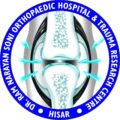Understanding Acetabular Fractures: Causes, Symptoms, and Treatment Options
Introduction
The acetabulum is a critical component of the hip joint, forming the socket where the femoral head (the ball-shaped end of the thigh bone) fits. Acetabular fractures, although relatively uncommon, can have significant consequences for an individual’s mobility and quality of life. In this blog post, we will delve into the causes, symptoms, and treatment options for acetabular fractures.
Causes of Acetabular Fractures
Acetabular fractures typically result from high-energy trauma, such as motor vehicle accidents, falls from a significant height, or sports injuries. The force required to fracture the acetabulum is often considerable, and the injury is frequently associated with other fractures or injuries to the pelvis.
Symptoms of Acetabular Fractures
- Pain and Swelling: Individuals with acetabular fractures often experience intense pain in the hip or groin area. Swelling and bruising may also be present.
- Inability to Bear Weight: Weight-bearing on the affected leg can be extremely painful, leading to a noticeable limp or reluctance to use the injured limb.
- Limited Range of Motion: A reduced range of motion in the hip joint is a common symptom, making it difficult for the individual to perform activities such as walking or bending at the hip.
- Visible Deformity: In severe cases, there may be a visible deformity or irregularity around the hip joint, indicating a displaced fracture.
Diagnosis of Acetabular Fractures
Accurate diagnosis of acetabular fractures is crucial for appropriate management. The following diagnostic tools may be employed:
- X-rays: X-ray imaging is often the initial diagnostic tool to assess the extent and location of the fracture.
- CT Scan: Computed tomography (CT) scans provide detailed, three-dimensional images of the acetabulum, helping to identify the specific type and severity of the fracture.
- MRI Scan: Magnetic resonance imaging (MRI) may be used to assess soft tissue injuries and provide additional information about the fracture.
Treatment Options
The management of acetabular fractures depends on various factors, including the type and severity of the fracture, the patient’s overall health, and associated injuries. Treatment options may include:
- Non-Surgical Management: Stable, nondisplaced fractures may be managed conservatively with rest, pain management, and physical therapy.
- Surgical Intervention: Displaced or unstable fractures often require surgical intervention. Common surgical techniques include open reduction and internal fixation (ORIF) and total hip arthroplasty (THA).
- Rehabilitation and Physical Therapy: Regardless of the chosen treatment approach, rehabilitation and physical therapy are crucial for restoring mobility, strength, and function in the affected hip joint.
- Long-Term Follow-Up: Patients with acetabular fractures may require long-term follow-up to monitor for complications, such as arthritis or avascular necrosis, and to assess the effectiveness of the chosen treatment.
Conclusion
Acetabular fractures are complex injuries that demand a comprehensive and individualized approach to treatment. Timely diagnosis and appropriate intervention can significantly impact the long-term outcome for individuals affected by these fractures. As research and medical technology continue to advance, the prognosis for acetabular fractures is expected to improve, offering hope for enhanced recovery and improved quality of life for those who experience these challenging injuries.

